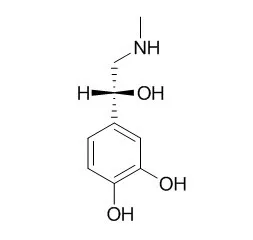| In vitro: |
| BMJ. 2013 Dec 10;347:f6829. | | Evaluation of pre-hospital administration of adrenaline (epinephrine) by emergency medical services for patients with out of hospital cardiac arrest in Japan: controlled propensity matched retrospective cohort study.[Pubmed: 24326886] | To evaluate the effectiveness of pre-hospital Adrenaline (epinephrine) administered by emergency medical services to patients with out of hospital cardiac arrest. DESIGN: Controlled propensity matched retrospective cohort study, in which pairs of patients with or without (control) Adrenaline were created with a sequential risk set matching based on time dependent propensity score. SETTING: Japan's nationwide registry database of patients with out of hospital cardiac arrest registered between January 2007 and December 2010.
METHODS AND RESULTS:
Among patients aged 15-94 with out of hospital cardiac arrest witnessed by a bystander, we created 1990 pairs of patients with and without Adrenaline with an initial rhythm of ventricular fibrillation or pulseless ventricular tachycardia (VF/VT) and 9058 pairs among those with non-VF/VT. Overall and neurologically intact survival at one month or at discharge, whichever was earlier. RESULTS: After propensity matching, pre-hospital administration of Adrenaline by emergency medical services was associated with a higher proportion of overall survival (17.0% v 13.4%; unadjusted odds ratio 1.34, 95% confidence interval 1.12 to 1.60) but not with neurologically intact survival (6.6% v 6.6%; 1.01, 0.78 to 1.30) among those with VF/VT; and higher proportions of overall survival (4.0% v 2.4%; odds ratio 1.72, 1.45 to 2.04) and neurologically intact survival (0.7% v 0.4%; 1.57, 1.04 to 2.37) among those with non-VF/VT.
CONCLUSIONS:
Pre-hospital administration of Adrenaline by emergency medical services improves the long term outcome in patients with out of hospital cardiac arrest, although the absolute increase of neurologically intact survival was minimal. | | Resuscitation. 2014 Mar;85(3):350-8. | | Adrenaline (epinephrine) dosing period and survival after in-hospital cardiac arrest: a retrospective review of prospectively collected data.[Pubmed: 24252225] | | BACKGROUND AND AIM:
Expert guidelines for treatment of cardiac arrest recommend administration of Adrenaline (epinephrine) every three to five minutes. However, the effects of different dosing periods of Adrenaline remain unclear. We sought to evaluate the association between Adrenaline average dosing period and survival to hospital discharge in adults with an in-hospital cardiac arrest (IHCA).
METHODS:
We performed a retrospective review of prospectively collected data on 20,909 IHCA events from 505 hospitals participating in the Get With The Guidelines-Resuscitation (GWTG-R) quality improvement registry. Adrenaline average dosing period was defined as the time between the first Adrenaline dose and the resuscitation endpoint, divided by the total number of Adrenaline doses received subsequent to the first Adrenaline dose. Associations with survival to hospital discharge were assessed by using generalized estimating equations to construct multivariable logistic regression models.
RESULTS:
Compared to a referent Adrenaline average dosing period of 4 to <5 min per dose, survival to hospital discharge was significantly higher in patients with the following Adrenaline average dosing periods: for 6 to <7 min/dose, adjusted odds ratio [OR], 1.41 (95%CI: 1.12, 1.78); for 7 to <8 min/dose, adjusted OR, 1.30 (95%CI: 1.02, 1.65); for 8 to <9 min/dose, adjusted OR, 1.79 (95%CI: 1.38, 2.32); for 9 to <10 min/dose, adjusted OR, 2.17 (95%CI: 1.62, 2.92). This pattern was consistent for both shockable and non-shockable cardiac arrest rhythms.
CONCLUSION:
Less frequent average Adrenaline dosing than recommended by consensus guidelines was associated with improved survival of in-hospital cardiac arrest. |
|






 Cell. 2018 Jan 11;172(1-2):249-261.e12. doi: 10.1016/j.cell.2017.12.019.IF=36.216(2019)
Cell. 2018 Jan 11;172(1-2):249-261.e12. doi: 10.1016/j.cell.2017.12.019.IF=36.216(2019) Cell Metab. 2020 Mar 3;31(3):534-548.e5. doi: 10.1016/j.cmet.2020.01.002.IF=22.415(2019)
Cell Metab. 2020 Mar 3;31(3):534-548.e5. doi: 10.1016/j.cmet.2020.01.002.IF=22.415(2019) Mol Cell. 2017 Nov 16;68(4):673-685.e6. doi: 10.1016/j.molcel.2017.10.022.IF=14.548(2019)
Mol Cell. 2017 Nov 16;68(4):673-685.e6. doi: 10.1016/j.molcel.2017.10.022.IF=14.548(2019)